Subnav

JUNE 12–OCTOBER 2, 2011

Turpitudes sociales
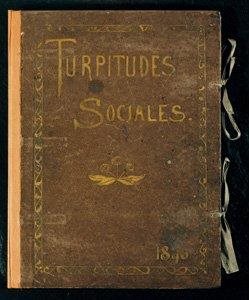


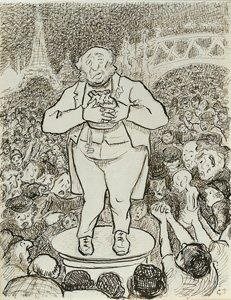
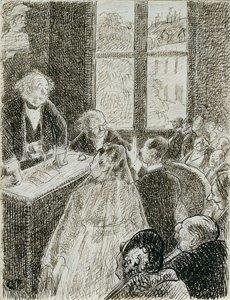
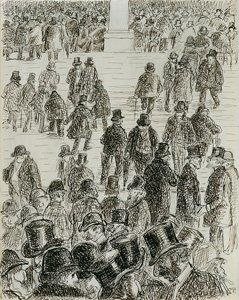
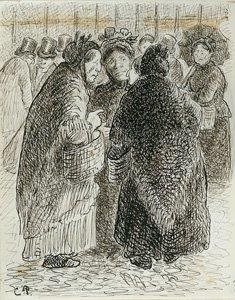
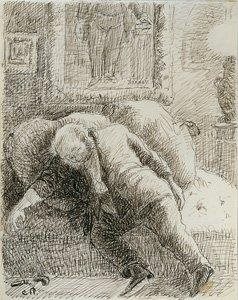
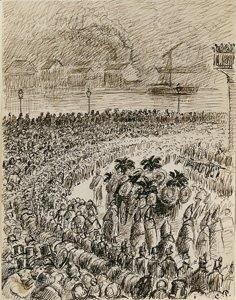
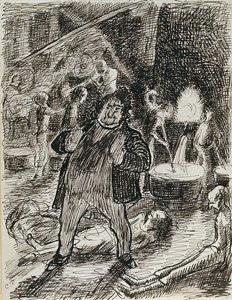
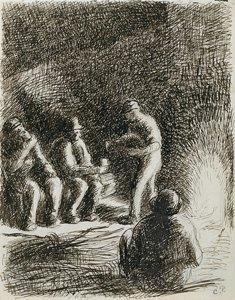
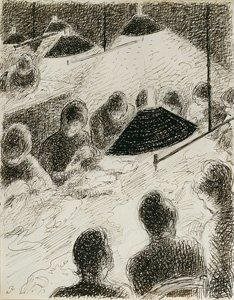
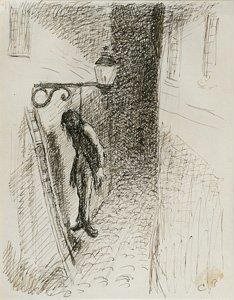
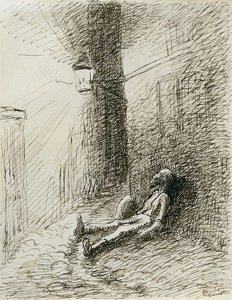
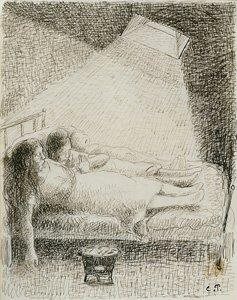
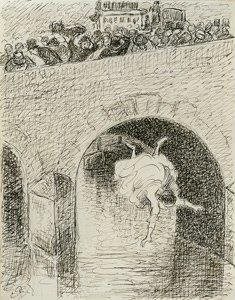
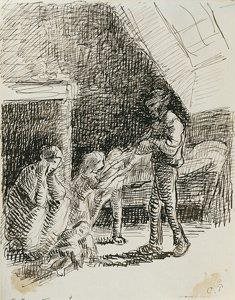
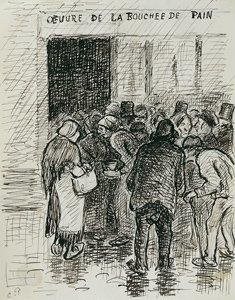
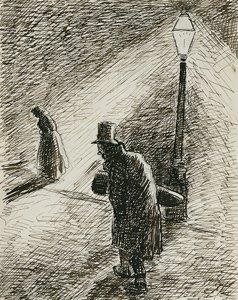
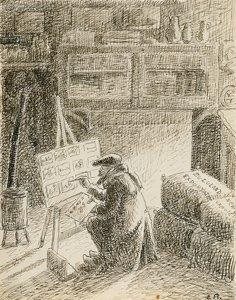
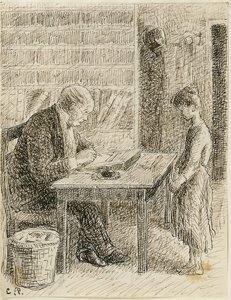
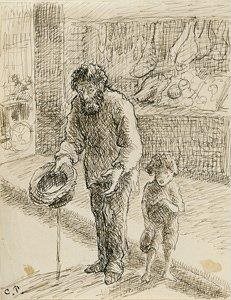


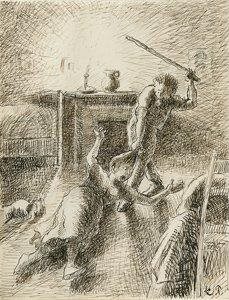
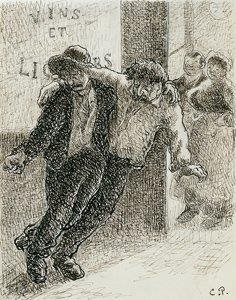
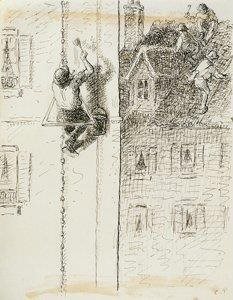
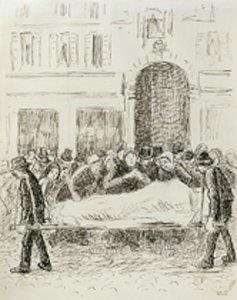
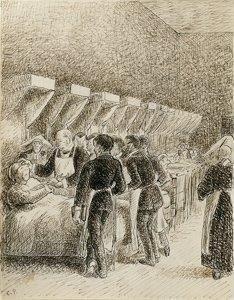
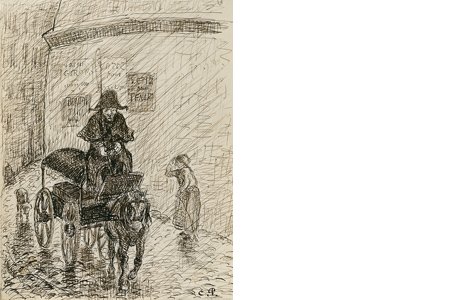
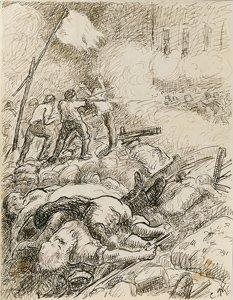
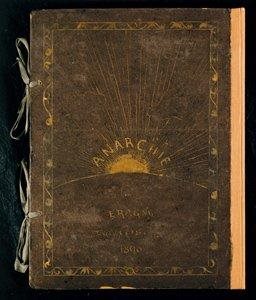
































Camille Pissarro, Cover by Lucien Pissarro
1830–1903, 1863–1944
Turpitudes sociales
1889–90
Thirty pen and brown ink over graphite drawings on paper pasted in an album, album: 12 1/4 x 9 1/2 in. (31 x 24 cm).
Collection of Jean Bonna, Geneva
Camille Pissarro
1830–1903
Turpitudes sociales
1889–90
Thirty pen and brown ink over graphite drawings on paper pasted in an album, album: 12 1/4 x 9 1/2 in. (31 x 24 cm).
Collection of Jean Bonna, Geneva
Camille Pissarro
1830–1903
Turpitudes sociales
1889–90
Thirty pen and brown ink over graphite drawings on paper pasted in an album, album: 12 1/4 x 9 1/2 in. (31 x 24 cm).
Collection of Jean Bonna, Geneva
Camille Pissarro
1830–1903
"Capital," from Turpitudes sociales
1889–90
Pen and brown ink over graphite drawings on paper pasted in an album, sheet: 12 1/4 x 9 1/2 in. (31 x 24 cm). Collection of Jean Bonna, Geneva
Camille Pissarro
1830–1903
"The Marriage of Reason," from Turpitudes sociales
1889–90
Pen and brown ink over graphite drawings on paper pasted in an album, sheet: 12 1/4 x 9 1/2 in. (31 x 24 cm).
Collection of Jean Bonna, Geneva
Camille Pissarro
1830–1903
"The Temple of the Golden Calf," from Turpitudes sociales
1889–90
Pen and brown ink over graphite drawings on paper pasted in an album, sheet: 12 1/4 x 9 1/2 in. (31 x 24 cm).
Collection of Jean Bonna, Geneva
Camille Pissarro
1830–1903
"Dabblers in the Stock Market," from Turpitudes sociales
1889–90
Pen and brown ink over graphite drawings on paper pasted in an album, sheet: 12 1/4 x 9 1/2 in. (31 x 24 cm).
Collection of Jean Bonna, Geneva
Camille Pissarro
1830–1903
"The Suicide of a Stockbroker," from Turpitudes sociales
1889–90
Pen and brown ink over graphite drawings on paper pasted in an album, sheet: 12 1/4 x 9 1/2 in. (31 x 24 cm).
Collection of Jean Bonna, Geneva
Camille Pissarro
1830–1903
"Burial of a Cardinal," from Turpitudes sociales
1889–90
Pen and brown ink over graphite drawings on paper pasted in an album, sheet: 12 1/4 x 9 1/2 in. (31 x 24 cm).
Collection of Jean Bonna, Geneva
Camille Pissarro
1830–1903
"Penal Servitude," from Turpitudes sociales
1889–90
Pen and brown ink over graphite drawings on paper pasted in an album, sheet: 12 1/4 x 9 1/2 in. (31 x 24 cm).
Collection of Jean Bonna, Geneva
Camille Pissarro
1830–1903
"Slaves at their Meal," from Turpitudes sociales
1889–90
Pen and brown ink over graphite drawings on paper pasted in an album, sheet: 12 1/4 x 9 1/2 in. (31 x 24 cm)
Collection of Jean Bonna, Geneva
Camille Pissarro
1830–1903
"The 'Prison' of Saint-Honoré," from Turpitudes sociales
1889–90
Pen and brown ink over graphite drawings on paper pasted in an album, sheet: 12 1/4 x 9 1/2 in. (31 x 24 cm)
Collection of Jean Bonna, Geneva
Camille Pissarro
1830–1903
"The Hanged Millionaire," from Turpitudes sociales
1889–90
Pen and brown ink over graphite drawings on paper pasted in an album, sheet: 12 1/4 x 9 1/2 in. (31 x 24 cm)
Collection of Jean Bonna, Geneva
Camille Pissarro
1830–1903
"Jean Misery," from Turpitudes sociales
1889–90
Pen and brown ink over graphite drawings on paper pasted in an album, sheet: 12 1/4 x 9 1/2 in. (31 x 24 cm)
Collection of Jean Bonna, Geneva
Camille Pissarro
1830–1903
"Asphyxiation," from Turpitudes sociales
1889–90
Pen and brown ink over graphite drawings on paper pasted in an album, sheet: 12 1/4 x 9 1/2 in. (31 x 24 cm)
Collection of Jean Bonna, Geneva
Camille Pissarro
1830–1903
"Suicide of an Abandoned Woman," from Turpitudes sociales
1889–90
Pen and brown ink over graphite drawings on paper pasted in an album, sheet: 12 1/4 x 9 1/2 in. (31 x 24 cm)
Collection of Jean Bonna, Geneva
Camille Pissarro
1830–1903
"No More Bread," from Turpitudes sociales
1889–90
Pen and brown ink over graphite drawings on paper pasted in an album, sheet: 12 1/4 x 9 1/2 in. (31 x 24 cm)
Collection of Jean Bonna, Geneva
Camille Pissarro
1830–1903
"For Next to Nothing," from Turpitudes sociales
1889–90
Pen and brown ink over graphite drawings on paper pasted in an album, sheet: 12 1/4 x 9 1/2 in. (31 x 24 cm)
Collection of Jean Bonna, Geneva
Camille Pissarro
1830–1903
"Misery in a Black Hat," from Turpitudes sociales
1889–90
Pen and brown ink over graphite drawings on paper pasted in an album, sheet: 12 1/4 x 9 1/2 in. (31 x 24 cm)
Collection of Jean Bonna, Geneva
Camille Pissarro
1830–1903
"Art in Stagnation," from Turpitudes sociales
1889–90
Pen and brown ink over graphite drawings on paper pasted in an album, sheet: 12 1/4 x 9 1/2 in. (31 x 24 cm)
Collection of Jean Bonna, Geneva
Camille Pissarro
1830–1903
"Sophie's Choice," from Turpitudes sociales
1889–90
Pen and brown ink over graphite drawings on paper pasted in an album, sheet: 12 1/4 x 9 1/2 in. (31 x 24 cm)
Collection of Jean Bonna, Geneva
Camille Pissarro
1830–1903
"The Beggar," from Turpitudes sociales
1889–90
Pen and brown ink over graphite drawings on paper pasted in an album, sheet: 12 1/4 x 9 1/2 in. (31 x 24 cm)
Collection of Jean Bonna, Geneva
Camille Pissarro
1830–1903
"Struggle for Life!," from Turpitudes sociales
1889–90
Pen and brown ink over graphite drawings on paper pasted in an album, sheet: 12 1/4 x 9 1/2 in. (31 x 24 cm)
Collection of Jean Bonna, Geneva
Camille Pissarro
1830–1903
"Virtue Rewarded," from Turpitudes sociales
1889–90
Pen and brown ink over graphite drawings on paper pasted in an album, sheet: 12 1/4 x 9 1/2 in. (31 x 24 cm)
Collection of Jean Bonna, Geneva
Camille Pissarro
1830–1903
"Little Scene of Married Life," from Turpitudes sociales
1889–90
Pen and brown ink over graphite drawings on paper pasted in an album, sheet: 12 1/4 x 9 1/2 in. (31 x 24 cm)
Collection of Jean Bonna, Geneva
Camille Pissarro
1830–1903
"The Drunkards," from Turpitudes sociales
1889–90
Pen and brown ink over graphite drawings on paper pasted in an album, sheet: 12 1/4 x 9 1/2 in. (31 x 24 cm)
Collection of Jean Bonna, Geneva
Camille Pissarro
1830–1903
"Before the Accident," from Turpitudes sociales
1889–90
Pen and brown ink over graphite drawings on paper pasted in an album, sheet: 12 1/4 x 9 1/2 in. (31 x 24 cm)
Collection of Jean Bonna, Geneva
Camille Pissarro
1830–1903
"After the Accident," from Turpitudes sociales
1889–90
Pen and brown ink over graphite drawings on paper pasted in an album, sheet: 12 1/4 x 9 1/2 in. (31 x 24 cm)
Collection of Jean Bonna, Geneva
Camille Pissarro
1830–1903
"The Hospital," from Turpitudes sociales
1889–90
Pen and brown ink over graphite drawings on paper pasted in an album, sheet: 12 1/4 x 9 1/2 in. (31 x 24 cm)
Collection of Jean Bonna, Geneva
Camille Pissarro
1830–1903
"The Cortege of a Poor Man," from Turpitudes sociales
1889–90
Pen and brown ink over graphite drawings on paper pasted in an album, sheet: 12 1/4 x 9 1/2 in. (31 x 24 cm)
Collection of Jean Bonna, Geneva
Camille Pissarro
1830–1903
"Insurrection," from Turpitudes sociales
1889–90
Pen and brown ink over graphite drawings on paper pasted in an album, sheet: 12 1/4 x 9 1/2 in. (31 x 24 cm)
Collection of Jean Bonna, Geneva
Camille Pissarro, Cover by Lucien Pissarro
1830–1903, 1863–1944
Turpitudes sociales
1889–90
Thirty pen and brown ink over graphite drawings on paper pasted in an album, album: 12 1/4 x 9 1/2 in. (31 x 24 cm)
Collection of Jean Bonna, Geneva
In December 1889, Pissarro sent a series of drawings to his nieces, Esther and Alice Isaacson, that were intended to educate the two women about the horrors of modern capitalist society. The sheets were bound within a cover designed by Pissarro’s eldest son, Lucien, and entitled Turpitudes sociales—translated roughly as “social disgraces.” The album is unique in Pissarro’s work in its overt expression of his political beliefs. Each drawing depicts a scene of disgrace, hardship, or scandal, and is accompanied by a passage taken from anarchist or literary texts. The title page features an aged, bearded man brooding from a hilltop overlooking Paris; the word anarchie vibrates over the city like rays from the rising sun. In the twenty-eight episodes that follow, Pissarro chronicles bourgeois marriages for money, the sumptuous burial of a cardinal, the horrible working conditions in factories, and the corruption of bankers. His parade of images illustrating suicides, starvation, poverty, drunkenness, and exploitation closes with a scene of violent insurrection by the urban working class.
The drawings have the look of being hastily sketched, although Pissarro is known to have labored over them, carefully choosing his scenes, characters, and captions. Pissarro sent twenty-two of the twenty-eight drawings to the Isaacsons in December 1889; he likely delivered the final six sheets by hand when he visited the sisters in London in late spring 1890. Perhaps Pissarro realized that sending this provocative political manifesto through the mail would have resulted in the book’s seizure and possibly his arrest.
Click to download the exhibition brochure (PDF) from Pissarro's People.

Richly illustrated with more than 200 paintings, works on paper, and archival images, this compelling volume offers a definitive portrait of one of the most passionately political painters of the nineteenth century.
